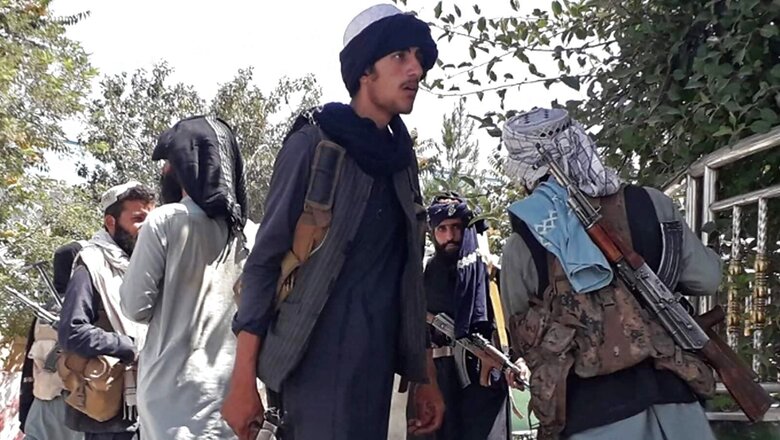
views
Two major cities in western and southern Afghanistan were on the verge of collapse to the Taliban on Thursday as the insurgency’s race to seize control of the country accelerated.
With the Taliban’s sudden gains in Kandahar, in the country’s southern Pashtun heartland, and Herat, a vital cultural and economic hub, the insurgents appear to be nearing a complete military takeover. Only four major cities — including the capital, Kabul — remain under government control, and two of them are under siege by the Taliban.
Both Kandahar and Herat had been heavily defended, with battles raging for weeks. But increasingly, the Afghan security forces appear to be collapsing, with many soldiers and policemen reported to be deserting or even changing sides in some places.
Both cities offer resonant victories for the Taliban, who have swept across the country in a brutal military campaign since international troops began withdrawing in May.
The insurgents now control more than half the country’s 400-odd districts. And with the fall of Kandahar and Herat, along with another provincial capital south of Kabul, Ghazni, and one in the northwest, Qala-e-Naw — all on Thursday — the insurgents will control 13 provincial capitals.
Kandahar, in particular, is a huge prize for the Taliban. It is the economic hub of southern Afghanistan, and it was the birthplace of the insurgency in the 1990s, serving as the militants’ capital during their five-year rule. By seizing the city, the Taliban can effectively proclaim a return to power, if not complete control.
For weeks, a mix of Afghan army, commando and special police units have desperately tried to hold Kandahar city as it came under Taliban siege. Then on Wednesday, the insurgents overran Kandahar’s central prison, freeing hundreds of inmates and in the process swelling their ranks — a tactic practiced for well over a decade.
By the following evening, Taliban fighters had broken through nearly every front line surrounding the city, according to members of the security forces.
Many Afghan forces retreated to the governor’s compound, which came under attack. The road to Kandahar’s airport also came under heavy fire from Taliban fighters. Within hours, nearly all commando and special police units had fled the city, effectively handing it over to the Taliban, according to officials and witnesses.
At the same time, in the northwest, the Taliban effectively seized control of most of Herat after security forces retreated.
For weeks, Afghan forces and militias loyal to Ismail Khan, a former warlord, struggled to fend off the insurgents as they advanced deeper into the city. But even with the added support of Afghan and U.S. air campaigns that have tried to slow the Taliban’s advance, security forces could not hold back the insurgents, officials said.
On Thursday, the Taliban broke through the front lines on the outskirts of the city and gained control of most government buildings, including police headquarters, as officers fled in civilian clothes, according to a spokesperson for the Herat police. The Taliban also seized Khan’s house — a symbolic prize that signaled the defeat of his militia forces. By Thursday evening, only the army corps compound remained under government control.
“Most compounds collapsed without fighting,” said Sami Nusrat, a spokesperson for the Herat police. “Some compounds and houses were burned down by the Taliban. The Taliban are opening fire into the air to celebrate.”
Ehsan Shafiq, a resident of Herat city, sheltered in his home Wednesday night after hearing the fighting outside intensify. By the following morning, an eerie quiet had fallen over the city as Taliban fighters flooded into the streets without resistance from government or militia forces.
“When they entered the police headquarters, it was empty, and when they entered the governor’s office, it was empty,” he said. “Wherever they went, the forces had already left the area. Now they stand at every square and are placed in government offices.”
It was a devastating 24 hours for government forces in Afghanistan.
On Thursday afternoon, the Taliban seized Ghazni, a provincial capital and strategic city about 90 miles south of Kabul. Hours later, they captured Qala-e-Naw, the capital of Badghis province, which neighbors Herat, after security forces retreated to an airport on the outskirts of the city, officials said. And in Lashkar Gah, the capital of Helmand province and the only other major southern city still nominally controlled by the government, the Taliban overran the police headquarters and a prison.
With the fall of Kandahar and Herat, the Taliban will have gained control of more than a dozen provincial capitals in just one week. The Taliban now control much of southern Afghanistan and the country’s entire eastern border with Iran. The insurgents have also nearly captured all of the north, once the heart of resistance to the Taliban. Its nearly complete collapse has sent morale plunging in the government and the security forces and poses a serious strategic setback.
Two of the four major cities that remain under government control — Lashkar Gah in the south and Mazar-i-Sharif in the north — are already under Taliban attack as the insurgents push for total military victory.
That outcome appears increasingly likely.
Afghan security forces, exhausted and overstretched by the Taliban’s advance, are collapsing across the country. On Wednesday, an entire Afghan army corps in the northern city Kunduz surrendered to Taliban fighters, who had seized control of the city a few days before. They handed over their weapons and vehicles to the insurgents and ceded control of the city’s airport, officials said.
As the Taliban have pressed on their brutal offensive, thousands of displaced people have flocked to Kabul, one of the last islands of government control not yet under siege. Hundreds of thousands of others have been trapped between fighting in city streets and airstrikes from the sky.
On Wednesday, the Pentagon moved thousands of U.S. Marines into position for a possible evacuation of the U.S. Embassy and U.S. citizens in Kabul. The Biden administration is bracing for a possible collapse of the Afghan government within 30 days, administration and military officials said.
Sharif Hassan and Christina [email protected] The New York Times Company
Read all the Latest News, Breaking News and Special: Live-updating IPL 2022 auction tally | IPL Mega Auction Live Updates here.




















Comments
0 comment